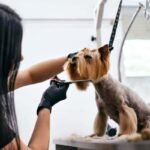Pugs are undeniably one of the most charming and beloved dog breeds, known for their distinct wrinkled faces, playful personalities, and affectionate nature. Their unique appearance and endearing antics have made them a favorite among dog lovers around the world. However, as with any breed, questions often arise regarding their purity and lineage. Are Pugs truly purebred dogs, or is there more complexity to their pedigrees than meets the eye?
In this article, we’ll delve into the world of Pug pedigrees, exploring what it means to be a purebred dog, the history of the breed, and the implications of breeding practices. By the end, you’ll have a clearer understanding of Pugs and their fascinating heritage, as well as tips for prospective owners looking to bring one of these delightful companions into their lives. So, let’s embark on this journey to uncover the truth about our beloved Pugs!
Table of Contents
- Understanding the Pug Breed Standard and Characteristics
- Exploring the Origins and History of Pugs
- Identifying Purebred Pugs: Key Traits and Registration
- Caring for Your Pug: Tips for Health and Wellbeing
- Q&A
- Key Takeaways
Understanding the Pug Breed Standard and Characteristics
The Pug is a small breed known for its distinctive appearance and lively personality. According to the breed standard, Pugs should possess a compact, square body, a short muzzle, and tightly curled tail. Key characteristics to look for include:
Size: Typically weighing between 14 to 18 pounds.
Coat: Short, smooth, and glossy with colors ranging from fawn to black.
Eyes: Large, dark, and expressive, giving the Pug its charming demeanor.
Temperament: Playful, affectionate, and sociable with a good-natured disposition.
Additionally, evaluating a Pug’s pedigree is essential for potential owners. A well-documented lineage often ensures the health and temperament of the dog. Here are some aspects to consider when examining a Pug’s pedigree:
| Aspect | Importance |
|---|---|
| Health Records | This helps identify genetic predispositions to common Pug health issues. |
| Champion Titles | Indicates quality of breeding and adherence to breed standards. |
| Socialization History | Can impact a Pug’s behavior and adaptability in various environments. |
Exploring the Origins and History of Pugs
Pugs, with their charming wrinkled faces and playful nature, can trace their lineage back to ancient civilizations. These adorable companions are believed to have originated in China around 400 B.C., where they were cherished by emperors and nobility. As valuable possessions, they were often kept in lavish settings, enjoying comforts that reflected their esteemed status. The breed was later introduced to Europe in the 16th century, primarily through Dutch traders. Pugs quickly captivated the hearts of many, making their home in the courts of royal families, including that of William III of England, who famously brought the breed to Britain.
The ancestry of pugs is fascinating and diverse, showcasing a blend of different breeds and influences. Their distinct characteristics can be attributed to interbreeding with various dog breeds such as the Bulldog and the Pekingese. In terms of physical traits, pugs are known for their compact size, curled tails, and expressive faces. Understanding their rich history can help potential owners appreciate the breed’s unique qualities and requirements. Here’s a brief overview of significant milestones in the history of pugs:
| Year | Event |
|---|---|
| 400 B.C. | Pugs first domesticated in China. |
| 16th Century | Pugs introduced to Europe by Dutch traders. |
| 1688 | Pugs favored by the House of Orange in the Netherlands. |
| 1885 | American Kennel Club recognizes the pug as a breed. |
Identifying Purebred Pugs: Key Traits and Registration
When searching for a purebred pug, it’s essential to be familiar with the specific traits that set them apart from mixed breeds. These adorable companions exhibit a number of distinct characteristics that can help you identify their purebred status. Look for the following key traits:
Compact Body: Pugs have a square-shaped body that is sturdy and muscular.
Wrinkled Face: Their signature wrinkled and short snout is a hallmark of the breed.
Curled Tail: A tightly curled tail adds to their distinctive appearance.
Large, Dark Eyes: Pugs have prominent eyes that can convey a range of emotions.
Coat Color: The typical coat colors include fawn and black, with fawn being the most common.
To further ensure that you are acquiring a purebred pug, consider examining their registration status. Reputable breeders will provide you with proper documentation, which can include:
| Registration Type | Description |
|---|---|
| AKC Registration | Indicates that the pug meets the American Kennel Club standards. |
| Pedigree Papers | Detailed lineage showing the pug’s ancestry and lineage. |
| Health Clearances | Documentation proving the pug’s health status and genetic screening. |
Being informed about these traits and registration details can greatly improve your chances of finding a healthy, purebred pug that fits perfectly into your family.
Caring for Your Pug: Tips for Health and Wellbeing
Pugs are lovable companions, but their unique physical characteristics and charming personalities come with specific health considerations. To ensure your pug thrives, regular vet check-ups are essential. This helps in early detection of common issues such as brachycephalic obstructive airway syndrome (BOAS) and hip dysplasia. Alongside routine veterinary care, maintaining a balanced diet tailored for small breeds will contribute significantly to their overall wellbeing. Here are some additional tips to keep your pug healthy:
Exercise regularly: Engage in daily walks and playtime to manage their weight.
Maintain dental hygiene: Regular tooth brushing helps prevent dental diseases.
Hydrate: Ensure fresh water is always available, especially during warmer months.
Monitor their environment: Keep your home cool, as pugs are sensitive to heat.
Another critical aspect of caring for your pug is socialization and mental stimulation. Pugs are social dogs that thrive on companionship, so if you spend long hours away, consider options like doggy daycare or hiring a pet sitter. Engaging your pug with toys, puzzles, and training sessions can also keep their minds sharp and reduce the chances of behavioral issues. Check out the following table for some enriching activities:
| Activity | Description | Benefits |
|---|---|---|
| Puzzle Toys | Interactive toys that dispense treats | Enhances problem-solving skills |
| Agility Training | Obstacle courses designed for dogs | Improves coordination and fitness |
| Play Dates | Arrange meet-ups with other friendly dogs | Boosts social skills and happiness |
Q&A
Q1: What is a purebred dog?
A1: A purebred dog is one that belongs to a specific breed and has a documented pedigree that verifies its lineage. This means both of its parents are of the same breed, and their ancestry can generally be traced back through several generations.
Q2: Are Pugs considered purebred dogs?
A2: Yes, Pugs are considered purebred dogs. The American Kennel Club (AKC) recognizes Pugs as a distinct breed, and they have specific breed standards that outline their physical and temperamental characteristics.
Q3: What does a Pug pedigree entail?
A3: A Pug pedigree is a record that traces the ancestry of a Pug dog through its parents and grandparents. A pedigree can provide information about the dog’s lineage, including titles and accomplishments, health histories, and potential genetic issues. A well-documented pedigree can help prospective owners understand more about the dog’s traits and potential health concerns.
Q4: How can I verify if my Pug is purebred?
A4: To verify if your Pug is purebred, you can ask for its pedigree papers from the breeder. These documents can provide proof of its lineage. Additionally, you can check with recognized breed clubs, such as the AKC, which can assist with registration and pedigree verification.
Q5: Can Pugs be mixed breed dogs?
A5: Yes, Pugs can be mixed breed dogs. When a Pug is bred with another breed, the offspring are typically referred to as “designer dogs” (e.g., Puggle, which is a mix of Pug and Beagle). These dogs will not be considered purebred Pugs, as their lineage includes another breed.
Q6: What are the benefits of owning a purebred Pug?
A6: Owning a purebred Pug can provide several benefits, including predictability in behavior and appearance based on the established breed standards. Additionally, a purebred Pug may come with a pedigree that gives insights into the dog’s genetic background, helping you anticipate potential health issues.
Q7: Are there health concerns associated with purebred Pugs?
A7: Yes, purebred Pugs are known to be prone to certain health issues, such as brachycephalic airway syndrome, hip dysplasia, and eye conditions due to their unique physical characteristics. Responsible breeders typically screen for these conditions to reduce the risk in their litters.
Q8: What should I look for in a reputable Pug breeder?
A8: When looking for a reputable Pug breeder, consider their experience, knowledge of the breed, and willingness to answer your questions. A good breeder will provide health clearances, a pedigree, and prioritize the well-being of their dogs. They should also allow you to meet the puppies’ parents and see the living conditions of the dogs.
Q9: Can I adopt a Pug?
A9: Absolutely! Many Pugs in need of homes can be found through rescues and shelters. Adopting a Pug can be a fulfilling option, and mixed breeds may offer the same affectionate personality traits as purebreds, along with potentially fewer health issues.
Q10: What makes Pugs unique?
A10: Pugs are known for their charming, affectionate nature and distinctive physical features such as a wrinkled face and curled tail. Their playful demeanor and adaptability make them wonderful companions for various lifestyles. Their unique mix of humor and loyalty truly sets them apart from many other breeds!
Key Takeaways
understanding whether pugs are purebred dogs involves delving into their rich history and intricate pedigree. While the charm and lovable nature of pugs have made them a popular breed across the globe, it’s essential to recognize the nuances of their breeding standards and genetics. Whether you’re considering adding a pug to your family or simply looking to learn more about this delightful breed, knowledge about their pedigree can help you appreciate their unique characteristics even more. Remember to support responsible breeding practices and consider adopting from shelters or reputable breeders who prioritize the health and well-being of their dogs. With the right information, you can ensure that your journey with a pug will be filled with joy and companionship. Happy pug parenting!

















